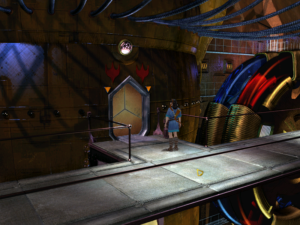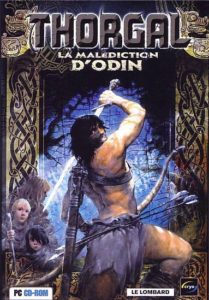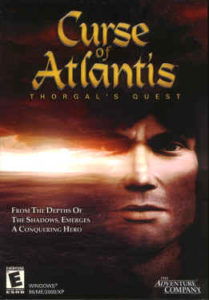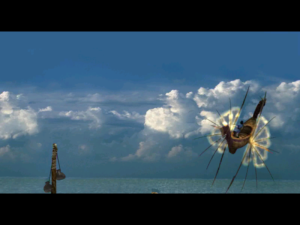Killer 7 is predicated in part on the same premise as Alan Moore’s From Hell: that serial murderers develop supernatural powers. Some of the Killer 7 personas have particular specialties, like Invisibility or Force Jump. But there are also powers they all share: they can all see the Heaven Smiles, which are invisible to ordinary humans, and they can all talk to ghosts. There are a few dead people who keep showing up repeatedly, like Travis, the “killer who got killed”. Most of the level bosses show up in levels after you kill them, too. Although they were your mortal enemies in life, they’re uniformly docile and helpful in afterlife, holding no grudge against you, which is a lot creepier than the alternative. Their combativeness was part of what made them human, even when they were thoroughly inhuman. Losing it, they seem… well, less alive. But I suppose that reducing people to things is what a hired assassin is all about. Even just contemplating the act requires dehumanizing the target.
There are a few hints dropped in the game that the Killer 7 themselves are ghosts as well, which would explain why they can’t be killed permanently. Garcian Smith, the Cleaner, is the only one who seems to have a normal existence. It’s Garcian who embarks on all the missions. Between times, we see him in his squalid little trailer home, eating pizza and enduring the shrieks and howls from wheelchair-bound Harman, who’s confined to his room and tormented by the maid. Everyone else seems to live inside the television. Garcian is the only one who has any contact with the outside world, and the only one who can’t transform into a different persona at will: every mission begins with him arriving at the site and then being replaced automatically when he passes by a security camera. He’s the only one who can really die. In short, he’s the only one who seems real.
Now, I had commented in my first post that the whole game seemed like a madman’s hallucinations. I stopped thinking about it that way after a while, because the game kept giving me more details about this strange world, and details work against doubt. One of the bosses has a long personal history with Dan Smith, and when you confront him in Dan’s persona, the game is temporarily all about Dan. This goes a long way toward convincing the player that Dan is real. You have to at least pretend that he’s real in order to follow the story. Suspension of disbelief. But the climactic mission, titled “Smile”, breaks this.
The first hint about what’s about to happen is the moon. Each mission uses a picture of the moon as a loading screen, enlarged and tinted in different bright colors. In Smile, it’s displayed for the first time in its natural grey. It’s a subtle thing, but somehow its meaning was clear: this is the mission where you come to see things as they really are. And so it was. I won’t go into detail about the final revelations, but the ending really calls into question just how much of the game actually happened. There are some recovered memories, some of which are clearly echoed in events that you earlier witnessed in cutscenes. There’s a point where you wind up back in Garcian’s trailer and Harman’s cries of agony are replaced by the sounds of machinery outside and the groaning of pipes. This is a sort of story that I think of as particularly Japanese (and even a little Buddhist): the anamnesis plot, the falling away of illusions and recovery of true self-knowledge, as seen in the likes of Silent Hill 2 and more than one Final Fantasy. It can be a very effective technique, provided the authors set it up well enough in advance, which this game certainly does.
But then the game then backtracks on this somewhat. A short final level, a sort of interactive epilogue, brings back the Heaven Smile, which otherwise disappeared from the scene without a trace when Garcian started learning the truth. A shorter, non-interactive epilogue shows Harman Smith and Kun Lan continuing their battle 100 years in the future, as if nothing had happened. You really have to read this game metaphorically sometimes, because reading it literally just doesn’t always work.
Plus, there’s just a wealth of metaphor to find. I haven’t even gotten into the political allegory. For example, one of the major plot elements is a conspiracy to control American presidential elections, with the Department of Education behind it all, because so many of the nation’s polling places are located in schools. This makes no sense if taken literally, but when you think about it, the educational establishment is very much involved in swaying elections by indoctrinating the next generation of voters. One reading of the whole game is that it’s really all about relations between Japan and America since WWII, with clues ranging from the blatant (I mean, come on, Trevor Pearlharbor?) to the less obvious (one character mentions a plan that has been in motion “for 65 years”. The game is set in 2010.) Actually, it’s not even a very speculative reading: a brewing conflict between the two nations is pretty much the literal overplot. The epilogue level has you explicitly choose sides, although your choice doesn’t seem to make a difference 100 years in the future. I mentioned before that you have to shoot at a person’s silhouette in order to enter the first mission. It turned out to be the silhouette of that mission’s end boss, and in fact the same thing is done in all subsequent missions. In the epilogue, you have to shoot at a silhouette of a flag. Because it’s just a silhouette, you can’t tell what nation it shows.
There’s a great deal of analysis of the story at GameFAQs. I can’t say I agree with all of it; much of it seems to take it for granted that everything we see in the game is supposed to be really happening, and I think the game itself discredits this notion pretty thoroughly. And ultimately, the game wants to confuse you. You can analyze it all you want, but if at the end of the day you’re not confused, you’re missing the point.
 Comments(0)
Comments(0)


